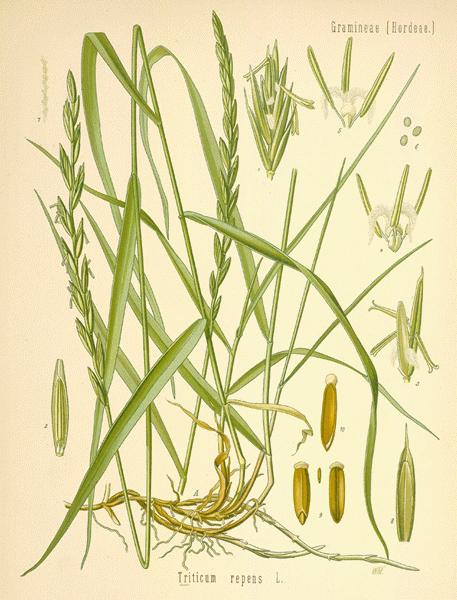Online there are as many suggested solutions to eradicating the creeping pest as it has nicknames. However all posters are agreed that the weed is hugely difficult to get rid of.
 |
| Couch grass, the rampant underground crawler |
It gets its most common name - couch grass - from ye olde days when it was commonly used as a stuffing material for couches and easy chairs - presumably because the abjectly indestructible stuff is almost impossible to break down and appears to last forever. Furniture restorers are seldom surprised to find 300 year old furniture pieces still containing visibly rigid straws of couch grass.
You'd understand how this works if you saw the state of my allotment - covered with what can only be described as a thick matting of four to five foot long strands of rhizones. The plant spreads by sending out these underground runners - although these are generally to be found just 10cm below the surface.
 |
| Couch Grass - Traditionally used for cushioning the seats of couches |
It's extraordinary how much ground it can cover over a few months. Pulling on a handful is like bringing up a spaghetti of electrical cables trained along a wall. Pop, pop, pop, and before you know it, the clump you've grasped has become a long rug of the stuff.
The cream coloured rhizones of scutch/couch grass were also used to make incense in medieval times when other more resinous materials were in short supply. That's another suggested way of getting rid of the stuff - burning it at every opportunity.
The problem with the couch grass plantation is that any process which chops it up will simply cause it to repopulate in greater numbers with every little shred and smidgen capable of regenerating to make another virulent new plant - just like Mickey Mouse's mop in the iconic "Sorcerer's Apprentice" sequence from Disney's "Fantasia."
 |
| More like this actually....A couch oozing antique couch grass yesterday |
A good many allotment holders and food growers to have tried to strim the stuff off, or have rotovated couch covered ground only to find themselves mired a few months later in a gardener's nightmare.
The most supported solution is to spray it off with weedkiller - not really an option if you have other food plants intact as a normal allotment would do. But in my case there's little being cultivated at the moment but the fruit trees and the rhubarb.
My brother - who runs the
maintenance division of a leading national landscaping firm is a veritable "doctor death" when it comes to expertise in weed killing poisons and chemicals. He says the only
solution is to "go chemical" - something I've never done before on my
allotment (apart from early experiments with bluestone and blue slug pellets). But it might be justified this time.
He says the use of a glyphosate based spray like
Roundup would not be detrimental to the soil - that the weed killing chemicals
won't linger and will dissipate as soon as I hit the ground. This I find hard to believe. However it may be the only answer to
the scutch plague.
| Roundup - the extreme option |
It certainly beats the option put forward by another allotment holder who suggests digging half a grave sized hole (three foot deep) in the ground, weeding out all your couch grass and burying it alive. Apparently the grass is unable to regenerate at this depth. But this seems like overkill to me (have you ever tried to dig a grave?!!).
So Roundup it is - at least so I can have some more time on the couch .

No comments:
Post a Comment